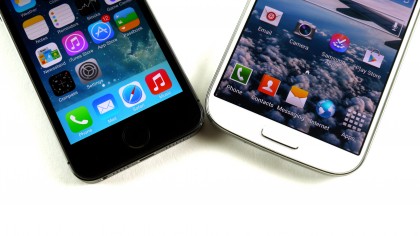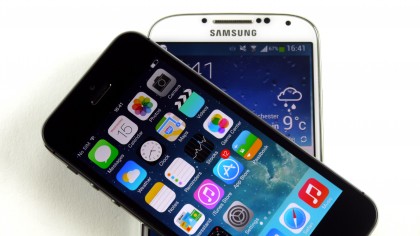Samsung Galaxy S4 vs iPhone 5S
Camera
If you're buying a new mobile, the camera is also likely to play a very important role. Whilst not able to entirely replace compact cameras, modern smartphones can produce some spectacular images and are always to hand.
Samsung has fitted the Galaxy S4 with a 13MP sensor, whilst Apple has fitted an 8MP sensor to the iPhone 5S. One word of warning though, we found that the Galaxy S4 defaulted to 16:9 photography meaning that the pictures captured were only 9.6MP, rather than the full 13MP captured in 4:3.
This has some advantages. The majority of mobile screens are now 16:9, as are the televisions and monitors that grace our living rooms and offices.
With mobile photos generally ending up on PCs and social media sites, this ratio would seem more appropriate to those looking to share their images, rather than those looking to create the perfect composition.
Samsung has included some added functions to help create a perfect composition however, making it slightly more useful for amateur photographers and professionals alike.
Within the settings menu it is possible to change ISO levels, white balance, exposure, as well as enabling the use of guidelines that break the screen into 9.
More novelty settings include a range of modes, including Beauty Face, Sound and Shot and Animated photo. These allow toggling to certain presets, whilst allowing the S4 to capture a verbal message with an image, or create a moving GIF.
Sign up for breaking news, reviews, opinion, top tech deals, and more.
With all this, it might seem a wonder why Apple iPhones are currently the top 4 camera devices used on Flickr. This is because the iSight cameras are stereotypically Apple; accomplished and simple to use, removing the extra settings that often get ignored. This leaves the camera app very uncluttered.
Within the settings menu of the iPhone, it is possible to change two settings; the 3 by 3 grid and whether to keep the normal photo alongside HDR images captured. Apple also offers 8 different filters, allowing for the addition of Instagram-esque effects .

The flash on the iPhone 5S appears brighter than on the Galaxy S4, however colours appear more washed out with much higher contrast levels appearing on the Samsung.

The iPhone 5S is able to capture much more detail in extreme low light situations, with much more detail from the car and of the houses opposite.

Colours appear far more vibrant on the Galaxy S4, with the image also looking a lot brighter and sharper - although the iPhone 5S does have a more natural image.

Colours are more contrasted on the Galaxy S4, with the more detail also being captured in the brighter areas. Galaxy S4 image feels sharper, with the added pixels helping produce a crisper image.

Storage and Extras
In battle of pure numbers, the Galaxy S4 beats the iPhone 5S hands down in one simple way; microSD support. Both handsets come in 16, 32 and 64GB variants, although the Samsung supports up to a further 64GB.
These cards are also hot swappable, allowing potential storage to be infinite (well, you know what we mean). Those with extremely large music and movie collections are only limited by the amount of microSD cards that they can fit in their pockets.
We will always recommend getting a larger storage option if you can on either device, with many HD apps and games now commanding over 1GB of space each.
Both the Samsung Galaxy S4 and iPhone 5S come with some level of voice activated personal assistant in the form of S Voice and Siri. The latter is obviously more well known and in our tests performed slightly better, if not 100% accurate.
The iPhone 5S also comes with a feature that sets it apart from almost every other handset on the market; Touch ID. Building a fingerprint scanner into the iPhone 5S' home button means that it is easy to hit, and it makes unlocking your iPhone simpler and quicker.
Apple has also included an M7 chip that constantly gathers data from accelerometers, gyroscopes, and compasses without needing to engage the A7 CPU. This enables more accurate tracking of work outs, as the chip can track your movements and distinguish between different journeys.
To make use of this extra chip, you will have to find a compatible app on the App store.
The Galaxy S4 might not come with a built in co-processor, but it does come with the S Health app preinstalled. This makes use of the in-built thermometer and barometer to measure comfort levels, as well as tracking your runs and your daily calorie intake.
A glance view also allows users to swipe their hands over the screen to get a quick glance at the time, notifications and battery charge status, as well as coming with a notifications light.

Verdict
Both the Samsung Galaxy S4 and the iPhone 5S are outstanding devices in their own rights, with very distinct personalities. Where the Samsung seems big and brash, the Apple seems calmer and more refined.
Having Android as the OS of the Galaxy S4 allows for levels of customisation that many iPhone owners dream of, with more control than just being able to change the wallpaper. It also allows for the addition of widgets, although this can sometimes make the UI feel cluttered where the iPhone 5S seems a lot simpler.
The added real estate, Full HD resolution of the 5-inch display coupled with expandable storage make the Samsung Galaxy S4 ideal for those that love to watch movies on the go, as well as those that have adapted to using both hands whist texting.
It also makes mobile gaming easier, with less of the screen being taken up with on screen thumbs.
Those looking to play more casual games may be more suited to the iPhone, although the 64-bit chip makes it slightly quicker to load the more graphic intensive games. Apple's iPhone 5S also comes with the added advantage of hooking up to iCloud, making it easy to sync between multiple iDevices.